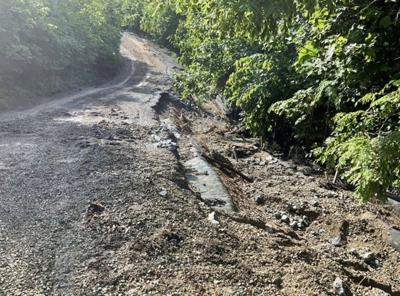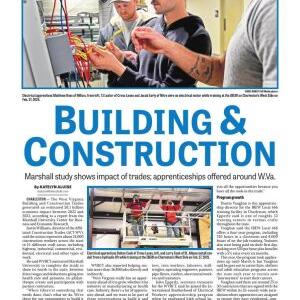Regulatory filings indicate the Mountain Valley Pipeline has been the source of more environmental issues in the days before and after it began to carry gas this month �����Ƶ� including another project rupture a month after a pipeline burst in southwest Virginia, fueling longstanding safety concerns.
An 8-inch pipe being used to dewater a section of the pipeline in Montgomery County ruptured on June 4, according to Virginia Department of Environmental Quality spokesperson John Giese.
While the release was not from a section of the pipeline�����Ƶ�s 42-inch steel pipe, it has reinforced opponent criticisms pipeline operations are unpredictable and unsafe.
Citing a posted by pipeline critic Jonathan Sokolow, a Virginia-based attorney, pipeline opponents say the rupture resulted in a geyser of water shooting several hundred feet into the night sky six days before Mountain Valley Pipeline LLC, the Washington County, Pennsylvania-based joint venture behind the pipeline, asked the Federal Energy Regulatory Commission to approve placing the pipeline into service.
Mountain Valley spokesperson Natalie Cox said the company could not confirm the content of the video. The DEQ cannot verify whether the video of the testing water discharge and has no information on the cause of the pipe failure, Giese said Monday.
DEQ records indicate a Mountain Valley representative reported a hydrostatic test water release near the intersection of U.S. Route 11 and Lafayette Road caused by an unexpected hose rupture and lasting 15 minutes before a valve was shut and the flow stopped. An unknown amount of water was released, causing erosion and carrying gravel into a drainageway on property owned by Mountain Valley and into a roughly 50-foot length of Indian Run, according to a DEQ incident report.
Cox said Monday the water release involved a faulty connector on an 8-inch jumper pipe that was transferring water used in hydrotesting and that all restoration, stabilization and erosion control device maintenance activities related to the incident have been completed.
Hydrostatic test water flowed within Indian Run to the confluence at the South Fork of Roanoke River, according to an environmental compliance report Mountain Valley filed with FERC on June 20.
DEQ third-party investigators inspected and photographed the impacted areas after the incident occurred and verified completion of restoration work through Mountain Valley photo documentation of finished restoration work, Giese said.
Second pipe rupture in 2 months
The rupture follows a May 1 rupture of the pipeline itself in the Bent Mountain area in Roanoke County, Virginia during water pressure testing. The rupture triggered a municipal water discharge during a pipe pressure test, according to the Virginia Department of Environmental Quality.
A Pipeline and Hazardous Materials Safety Administration spokesperson has said mechanical fitting that failed during the testing on May 1 is being analyzed and that one other similarly manufactured component has been removed from the pipeline system as a precaution.
The spokesperson said Mountain Valley has completed all PHMSA pre-commissioning safety requirements and all provisions of an October consent order and agreement between the parties requiring Mountain Valley corrective safety measures after PHMSA found project conditions may pose safety risks.
Denali Nalamalapu, spokesperson for Protect Our Water, Heritage, Rights, a coalition of West Virginia and Virginia groups opposing the pipeline, said in an email Monday the �����Ƶ�uncovering of more MVP disasters�����Ƶ� was no surprise and �����Ƶ�must be a lesson to all government officials and financial institutions to never let this happen again.�����Ƶ�
Mountain Valley has persisted in asking FERC to expand space devoted to the project due to environmental difficulties since the project was placed into service on June 14.
Mountain Valley on Tuesday filed a request to increase the project limits of disturbance in Wetzel County by a tenth of an acre to remediate a land slip. The company said the project may include regrading the area to a more stable contour and installing drains, riprap, water bars and rock armoring.
The Tuesday filing followed another yet-to-be-approved request Mountain Valley filed June 17 to raise mainline valve structures above expected flooding levels in Harrison County.
The project would include installation of elevated platforms and foundations with stairs, ladders and safety rails, extending and relocating equipment at the mainline valve site, according to the company.
The project was necessary for constructability and operations access, Mountain Valley said, citing a May 8 email in which Harrison County code enforcement officer Robert Leonard said work could be completed under the current project permit as discussed by phone that afternoon.
That work included increasing the height of piping at the mainline valve site, according to an email from a representative of Mountain Valley lead developer Equitrans Midstream Corp.
The Monroe County-based Indian Creek Watershed �����Ƶsociation accused Mountain Valley of misleading regulators and the public in a letter to FERC filed the next day, saying the need for a variance request appeared to be withheld until after FERC authorized putting the pipeline into service.
Mountain Valley Pipeline project variance requests attributed to slope stability concerns have been common since work on the project recommenced last year after an act of Congress �����Ƶ� the Fiscal Responsibility Act �����Ƶ� forced completion of the 303.5-mile pipeline crossing 11 West Virginia counties.
More than three-quarters of the pipeline route in West Virginia is considered to have a high incidence of �����Ƶ� and high susceptibility to �����Ƶ� landslides, according to a final environmental impact statement issued by FERC staff.
The pipeline, which came at a $7.85 billion project price tag since it was first announced in 2014, is designed to transport up to 2 billion cubic feet per day of gas from the Marcellus and Utica shale formations in West Virginia to markets in the Mid-Atlantic and Southeastern United States. But the pipeline hasn�����Ƶ�t been expected to carry gas anywhere near capacity upon startup due to bottlenecks in another pipeline system.













